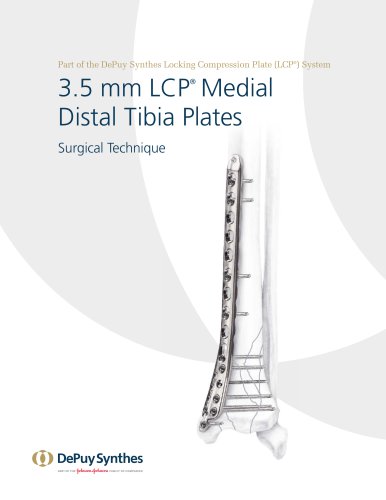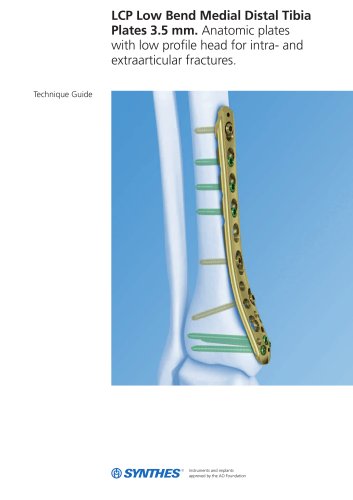 Website:
Depuy Synthes
Website:
Depuy Synthes
Group: Johnson & Johnson
Catalog excerpts

System for Stable Fixation of the Chest Wall MatrixRIB Fixation System Reference Guide
Open the catalog to page 1
Indications, Contraindications, Warnings, and MRI Information 4 MatrixRIB Fixation System 6 SURGICAL TECHNIQUE Plating Rib 9 MIPO INSTRUCTIONS Minimally Invasive Plate Osteosynthesis (MIPO) 39 Trocar Instruments Instructions for MatrixRIB 40 Fixation System Threaded Reduction Tool Instructions 43 MatrixRIB Fixation System CHEST WALL DEFECT REPAIR Chest Wall Reconstruction 49 Chest Wall Deformity Repair 57 PRODUCT INFORMATION Implants 61 MatrixRIB® Fixation System Reference Guide DePuy Synthes
Open the catalog to page 2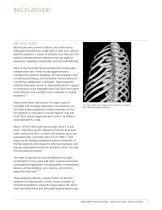
RIB FRACTURES Rib fractures are common in blunt chest wall trauma. Although fractured ribs usually heal on their own without specific treatment, a subset of patients have fractures that produce overlaying bone fragments that may produce severe pain, respiratory compromise, and chest wall deformity. Most of the fractured ribs are treated with conservative nonoperative care. These include aggressive pain management (epidural analgesia, rib oral analgesics and/ or bracing techniques), and ventilation and tracheotomy1 until fibrous stabilization is achieved. These treatment methods have been...
Open the catalog to page 4
PECTUS Pectus Excavatum is the most common congenital chest wall deformity where the sternum is depressed. Another less common deformity of the sternum, known as Pectus Carinatum, is where the sternum protrudes. While cosmetics/appearance of the chest wall is the primary concern with Pectus Carinatum, almost all patients with severe Pectus Excavatum indicate that they have progressive symptoms of early fatigability, dyspnea, decreased endurance, tachycardia, and tachypnea with physical exertion. With moderate-to-severe Pectus Excavatum, the heart is often displaced into the left chest and...
Open the catalog to page 5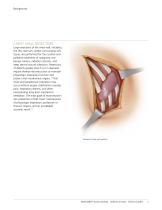
CHEST WALL RESECTION Large resections of the chest wall, including the ribs, sternum, and/or surrounding soft tissue, are performed for the curative and palliative treatment of malignant and benign tumors, radiation necrosis, and deep sternal wound infections. Resections of defects greater than 5 cm in diameter require skeletal reconstruction to maintain physiologic respiratory function and protect vital intrathoracic organs.12 Flail chest and paradoxical respiration may occur without proper stabilization causing pain, respiratory distress, and often necessitating long-term mechanical...
Open the catalog to page 6
INDICATIONS The DePuy Synthes MatrixRIB Fixation System is indicated for use in skeletally mature patients with normal or osteoporotic bone for chest wall fixation, where: DePuy Synthes MatrixRIB precontoured plates are indicated for the fixation, stabilization and reconstruction of: • Rib fractures, fusions, osteotomies, and/or resections, including spanning gaps and/or defects • Pectus Excavatum, Pectus Carinatum, and other chest wall deformities DePuy Synthes MatrixRIB straight plates are indicated for the fixation, stabilization and reconstruction of: • Rib and sternum fractures,...
Open the catalog to page 7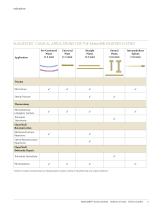
*Selection of plates should be based on individual patient anatomy, severity of injury/deformity, and surgeon preference. MatrixRIB® Fixation System Reference Guide DePuy Synthes 5
Open the catalog to page 8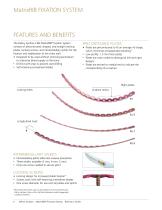
MatrixRIB FIXATION SYSTEM FEATURES AND BENEFITS The DePuy Synthes CMF MatrixRIB® Fixation System consists of precontoured, shaped, and straight locking plates, locking screws, and intramedullary splints for the fixation and stabilization of the chest wall. • Designed to be used without removing periosteum to maximize blood supply to the bone • Drill bit with stop to prevent over-drilling • Self-retaining screwdriver blades PRECONTOURED PLATES • Plates are precontoured to fit an average rib shape, which minimizes intraoperative bending3 • Low profile, 1.5 mm thick plates • Plates are color...
Open the catalog to page 9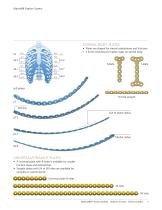
MatrixRIB Fixation System STERNAL BODY PLATES rib 3 • Plates are shaped for sternal osteotomies and fractures • 2.8 mm thickness for higher loads on sternal body Left plates 10 hole straight L3 Etching Out of plane radius L4-5 UNIVERSAL/STRAIGHT PLATES • A universal plate with 8 holes is available for smaller fracture areas and osteotomies • Straight plates with 24 or 30 holes are available for complex or custom bends Universal plate–8 holes 24 hole 30 hole MatrixRIB® Fixation System Reference Guide DePuy
Open the catalog to page 10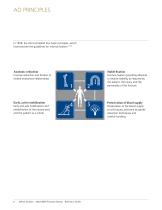
In 1958, the AO formulated four basic principles, which have become the guidelines for internal fixation.13,14 In 1958, the AO formulated four basic principles, which have become the guidelines for internal fixation1, 2. Anatomic reduction Anatomic reduction Fracture reduction and fixation to Fracture reduction and fixation to restore anatomical relationships. restore anatomical relationships. 1 Early, active mobilization Early, active mobilization Early and safe mobilization and Early and safe mobilization and rehabilitation of the injured part rehabilitation of the injured part and the...
Open the catalog to page 11
Rib Plating Technique Rib Plating Technique
Open the catalog to page 12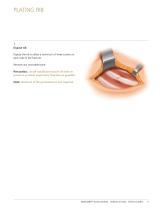
1 Expose rib Expose the rib to allow a minimum of three screws on each side of the fracture. Remove any nonviable bone. Precaution: Avoid significant muscle division to preserve as much respiratory function as possible. Note: Removal of the periosteum is not required. MatrixRIB® Fixation System Reference Guide DePuy Synt
Open the catalog to page 13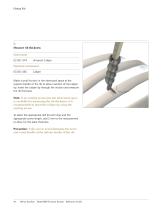
2 Measure rib thickness Instrument 03.501.074 Universal Caliper Optional instrument 03.501.065 Caliper Make a small incision in the intercostal space at the superior border of the rib to allow insertion of the caliper tip. Insert the caliper tip through the incision and measure the rib thickness. Note: If an existing access into the intercostal space is available for measuring the rib thickness, it is recommended to insert the caliper tip using the existing access. To select the appropriate drill bit with stop and the appropriate screw length, add 2 mm to the measurement to allow for the...
Open the catalog to page 14
3 Approximate broken rib segments Instrument 398.40 Reduction Forceps with points, narrow, ratchet, 132 mm length Use the forceps to approximate the broken rib segments. 4 Cut and contour plate template (optional) Instrument 03.501.090 Bending Template for MatrixRIB Locking Plates, 300 mm length Cut the bending template to a length that allows placement of a minimum of three screws on each side of the fracture. Contour the template to the rib. MatrixRIB® Fixation System Reference Guide DePuy Synthes
Open the catalog to page 15All Depuy Synthes catalogs and technical brochures
-
ZERO-P NATURAL™PLATE
5 Pages
-
2.0 mm LCP® Distal Ulna Plate
20 Pages
-
SYNFLATE SYSTEM
3 Pages
-
2.4 mm VA LCP™
4 Pages
-
Building on Success
16 Pages
-
HEALIX ADVANCE
4 Pages
-
RADIUS OF CURVATURE
3 Pages
-
Introducing The Variable Angle
12 Pages
-
HEALIX Anchor™ 3.4 mm
2 Pages
-
Small Battery Drive II
4 Pages
-
HEALIX ADVANCE
4 Pages
-
3.5 mm LCP™ Medial
15 Pages
-
Titanium Sternal Fixation System
34 Pages
-
Mandible Trauma Solutions
2 Pages
-
Power line II
4 Pages
-
Concorde
28 Pages
-
LCP Intercarpal
31 Pages
-
LCS® COMPLETE™
2 Pages
-
Synthes TPLO.
8 Pages
-
SynFix-LR System
56 Pages
-
ATB Anterior Tension Band Plate
32 Pages
-
CONDUIT™
15 Pages
-
Brochure_FINAL
2 Pages
-
DePuy Synthes
81 Pages
-
Anspach
3 Pages
-
Orthopedic Foot Instruments
32 Pages
-
PINNACLE® Hip Solutions
12 Pages
-
Corail
24 Pages
-
S-ROM® NOILES™
68 Pages
-
TRI-LOCK® Product Rationale
12 Pages
-
Reclaim Surgical Technique
44 Pages
-
Speed
2 Pages
-
attune
80 Pages
-
HAMMERLOCK® 2
2 Pages
-
DePuy Glenoid Solutions
2 Pages
-
Trauma Solutions. Elbow
4 Pages
-
Polar
4 Pages
-
Alveolar Distractor.
4 Pages
-
Piezoelectric System
4 Pages
-
Air Power Line II
6 Pages
-
LCP Clavicle Hook Plate
4 Pages
-
TruMatch Pin Guides
16 Pages
-
P F N A
8 Pages
-
SKILL, DEDICATION,
16 Pages
-
Orthopaedics. Overview
20 Pages
-
DURALOC
16 Pages
-
Marathon Cemented Cup
20 Pages
-
REEF Surgical Technique
16 Pages
-
MatrixNEURO
8 Pages
-
Anspach XMax
4 Pages
-
Anspach eMax 2 Plus
4 Pages
-
Small Electric Drive
4 Pages
-
Air Pen Drive
4 Pages
-
Colibri II
4 Pages
-
Spine
25 Pages
-
Expert Hindfoot Arthrodesis Nail
48 Pages
-
LCP Distal Fibula Plates
32 Pages
-
TomoFix
60 Pages
-
Expert Tibial Nail PROtect
16 Pages
-
Expert Tibia Nail
84 Pages
-
Sacral Bars
16 Pages
-
Pelvic C-Clamp
20 Pages
-
Low Profile Pelvic System
16 Pages
-
Proximal Femoral (Hook) Plate
24 Pages
-
LCP
24 Pages
-
PFNA
112 Pages
-
HCS 1.5, 2.4, 3.0
36 Pages
-
LCP Wrist Fusion
32 Pages
-
LCP Compact Hand
28 Pages
-
VA-LCP Elbow
48 Pages
-
Distal Radius
44 Pages
-
Olecranon
30 Pages
-
LCP Hook Plate
28 Pages
-
DHP & Olecranon
4 Pages
-
LCP S-A
4 Pages
-
Epoca
4 Pages
-
Philos
32 Pages
-
MultiLoc
68 Pages














